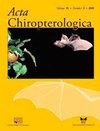The Role of the Adjacent Habitat on Promoting Bat Activity in Vineyards: A Case Study from Central Chile
IF 0.7
4区 生物学
Q4 ZOOLOGY
引用次数: 3
Abstract
Conversion of natural land covers to agriculture is a major cause of the global biodiversity decline. Bats are an important component of biodiversity in agricultural landscapes because they provide pest control services. Although management recommendations towards the enhancement of insectivorous bat populations in agro-ecosystems have previously been highlighted, little information is available for promoting bat conservation within viticultural landscapes. In the present study, we examined the role of the adjacent habitat on bat activity in vineyards of central Chile. We also evaluated differences in bat activity between the edges and the interiors of the vineyards in relation to the type of adjacent habitat. To accomplish this, we conducted acoustic surveys along edge and the interior of 16 vineyards bordering different adjacent habitats. Overall bat activity in vineyards was not influenced by the adjacent habitat type, but it was by the location within the vineyard; edges showed significant higher activity than the interior of the vineyards. Vineyards adjacent to native vegetation showed the highest levels of activity for Lasiurus varius, Lasiurus villosissimus and Myotis chiloensis compared to those adjacent to monoculture or urban areas. All bat species were most active at the edges of the vineyards as compared to the interior, which increase the probability of this group providing ecosystem services in vineyards. Therefore, vineyard edges, in particular those adjacent to native vegetation, should be considered as part of agricultural management in order to promote bat diversity and abundance in this crop.邻近栖息地对促进葡萄园蝙蝠活动的作用:以智利中部为例
将自然土地覆盖转为农业是全球生物多样性下降的主要原因。蝙蝠是农业景观中生物多样性的重要组成部分,因为它们提供害虫防治服务。尽管之前已经强调了提高农业生态系统中食虫蝙蝠种群的管理建议,但在葡萄栽培景观中促进蝙蝠保护的信息很少。在本研究中,我们考察了邻近栖息地对智利中部葡萄园蝙蝠活动的影响。我们还评估了葡萄园边缘和内部蝙蝠活动与相邻栖息地类型之间的差异。为了实现这一点,我们沿着16个葡萄园的边缘和内部进行了声学调查,这些葡萄园毗邻不同的栖息地。葡萄园中蝙蝠的总体活动不受邻近栖息地类型的影响,但受葡萄园内位置的影响;边缘表现出明显高于葡萄园内部的活性。与单一种植或城市地区附近的葡萄园相比,与原生植被相邻的葡萄园表现出最高水平的变异葡萄园、绒毛葡萄园和冻疮葡萄园的活性。与内部相比,所有蝙蝠物种在葡萄园边缘最为活跃,这增加了这一群体在葡萄园提供生态系统服务的可能性。因此,葡萄园边缘,特别是与原生植被相邻的边缘,应被视为农业管理的一部分,以促进蝙蝠在这种作物中的多样性和丰富性。
本文章由计算机程序翻译,如有差异,请以英文原文为准。
求助全文
约1分钟内获得全文
求助全文
来源期刊

Acta Chiropterologica
生物-动物学
CiteScore
2.50
自引率
20.00%
发文量
42
审稿时长
>12 weeks
期刊介绍:
Acta Chiropterologica, published by the Museum and Institute of Zoology at the Polish Academy of Sciences, is devoted solely to the study and discussion of bats.
 求助内容:
求助内容: 应助结果提醒方式:
应助结果提醒方式:


